
Ling He
Xi’an Jiaotong University, China
Title: Hydrophobic, hydrophilic and amphiphilic silica/copolymer nanoparticles by surface-initiated atom transfer radical polymerization
Biography
Biography: Ling He
Abstract
Silica/diblock copolymer nanoparticles (SDCNs) are synthesized by surface-initiated atom transfer radical polymerization (SI-ATRP) for hydrophobic, hydrophilic and amphiphilic materials, their properties as protein-resistance coatings are investigated. The hydrophobic SDCNs of SiO2-g-PMMA-b-P12FMA is synthesized by methyl methacrylate (MMA) and dodecafluoroheptyl methacrylate (12FMA) using silica surface initiator (SiO2-initiator with a density of 0.573 mmol·g-1). The three mass rations of hydrophobic SDCNs are proved as 25–30 nm core–shell particles in CHCl3 solution composed of P12FMA core and PMMA shell, but densely twined together as agglomerated particles. The increasing P12FMA content could obviously increase the surface roughness of the film (50-500 nm) and thereby contributes to the hydrophobic (112-118º) and oleophobic (45-78º) properties with lower water absorption and viscoelasticity, but a high thermo stability at 420-450℃. The amphiphilic SDCNs of SiO2-g-P(PEGMA)-b-P(12FMA) is prepared by poly (ethylene glycol) methyl ether methacrylate (PEGMA) and P12FMA. Their amphiphilic behavior, lower critical solution temperature (LCST), and surface properties as protein-resistance coatings are characterized. The individual spherical nanoparticles (150 nm -170 nm) as P(PEGMA)-b-P(12FMA) shell grafted on SiO2 core (130 nm) to gain obvious low LCST at 36-52℃ and high thermo stability at 290-320℃. The water-casted SiO2-g-P(PEGMA)-b-P(12FMA) films obtained much rougher surface (125.3–178.4 nm) than THF-casted films (11.5–16.9 nm). Therefore, the water-casted surfaces exhibit obvious high water adsorption amount and hard adsorbed layer, but present loser adsorbed layer than THF-casted films. While, the introduction of P (12FMA) segments does not show obviously reduce in the protein-repelling adsorption of SiO2-g-P(PEGMA)-b-P(12FMA) films. The hydrophilic SDCNs of SiO2-g-P(PEGMA)-b-P(PEG) is prepared by PEGMA and poly(ethylene glycol) methacrylate (PEG). Their temperature sensitive behavior, pH response and surface properties as protein-resistance coatings are characterized. 220 nm core-shell nanoparticles are formed in water solution, which gained LCST at 60-77ËšC and good dispersion in water when pH>5.0. The introduction of P(PEG) segments could increase the protein-repelling adsorption of SiO2-g-P(PEGMA)-b-P(PEG) films. Therefore, these SDCNs are suggested to be used as protein resistance coatings.

Figure.1: Synthesis of hydrophobic SiO2-g-PMMA-b-P12FMA and the aggregation of amphiphilic SiO2-g-P (PEGMA)-b-P (12FMA)

